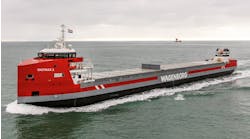Marine searchlights from ColorLight’s are suited to offshore applications such as navigation and maneuvering, search and rescue, oil spill detection, and helicopter landing. The company’s latest delivery to an offshore customer was earlier this year for Atlantic Towing’s supply vesselAtlantic Eagle. It currently has a follow-up order to supply another of the Canadian contractor’s vessels.
According to Colorlight’s president, Lennart Gudmundsson, the company was the first to offer a searchlight with two lamphouses on an axis, mounted on a pillar. The motor-driven axes can be turned continuously by means of the company’s proprietary slip-ring technology.
The lamps are fitted with parabolic reflectors developed according to Fresnel’s optical theory. They use specially developed light bulbs from Osram. The result is probably the sharpest white light in the market for marine applications, Gudmundsson claims: ColorLight’s smaller model, CL02-11, which has 250W halogen lights, outputs one lux at 2,000 m, while the CL03-11, with 575W HMI lights, provides one lux at 4,000 m.
Black light
The searchlights also can be fitted with ultraviolet bulbs to produce `black light’. Though UV beams are not visible to the human eye, they generate a visible light when they hit fluorescent material. Since life-jackets and other marine work-wear increasingly incorporate fluorescent material, black light provides an effective means of searching for a man overboard at night. Being able to penetrate fog and snow - conditions in which white light is reflected - it is also effective in conditions of poor visibility.
Black light is also the key to detecting oil spills in darkness, which is almost impossible with white light. Hydrocarbons contain fluorescent elements - when lit by UV light these change color, rendering the oil slick distinguishable from the surrounding water.
The searchlights can be controlled either manually with a joystick, or programmed for automatic functions such as panning. As black light cannot be seen, the ultraviolet models come with a position indicator showing where the beam points. Black light also can be used for helideck illumination. For this purpose ColorLight produces the CL04-02 model with a single lamphouse.
ColorLight searchlights are fitted on more than 25 types of vessel, including Fred Olsen’sKnock Nevis, the world’s largest tanker, currently serving as a floating storage unit in Qatar. The company recently delivered CL03-11 searchlights to Stena Bulk’s newbuild ice-class tankers Stena Arctica and Stena Atlantica, and has orders for Stena Antartica and a further Stena Bulk newbuild. Another recent delivery was a CL03-22 model with twin UV lights to Esvagt, a Danish operator of emergency response and search and rescue vessels.
For more information contact Lennart Gudmundsson, ColorLight. Tel +46 35 382 78, fax +46 35 382 79,[email protected], www.colorlight.com




